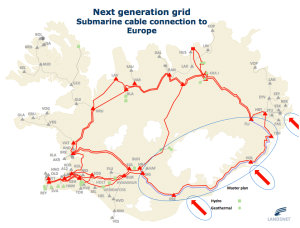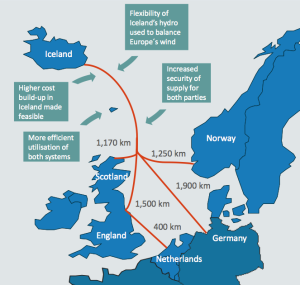HVDC Subsea Link
Today, Iceland is a closed electricity market with no cable connections to other markets. If an ongoing study on linking the Icelandic and Western European electricity markets with a subsea cable has positive results, however, Iceland could soon gain access to a market where electricity prices have generally been much higher than those in Iceland.
 This option becomes especially intriguing considering that Iceland could produce substantially more renewable electricity by using some of its unharnessed hydro- and geothermal resources. In addition, such a connection would open up possibilities of large-scale harnessing of wind power in Iceland.
This option becomes especially intriguing considering that Iceland could produce substantially more renewable electricity by using some of its unharnessed hydro- and geothermal resources. In addition, such a connection would open up possibilities of large-scale harnessing of wind power in Iceland.
Such an interconnector would not only enable sales of renewable electricity at high prices but also have various other benefits for the Icelandic electricity system. It would for example enable more efficient use of the generation capacity and enhance the security of supply.
An interconnecting subsea cable between Iceland and neighboring countries has been discussed for decades. However, it is only recently that technology advancement made it a realistic option to connect Iceland with other European countries with such a cable.
In 2010 the Icelandic electricity company Landsvirkjun started a new study on evaluating the feasibility of a high voltage direct current (HVDC) cable between Iceland and Europe. This would be the world’s longest submarine HVDC power cable and the study addresses issues like potential business models, markets, and congestion management.
Three scenarios are being studied. The first, concerns an interconnector that would be used for export/import only, based on market prices. The second involves a cable used for export only, and the third assumes an interconnector used in part for export/import and in part for export.
The cable would be at least 1,000 km in length, which is almost double the length of the longest existing subsea HVDC cable today: the NorNed interconnector between Norway and the Netherlands. If the cable would go all the way to the European continent (instead of only to Scotland) its length would be around 1,900 km.
The maximum depth under the ocean would be about 1,000 m and the transmission capacity would probably be between 600 and 1,000 MW. We will be following the ongoing developments regarding this study closely and publish frequent news and reports about the subject here on our website.





